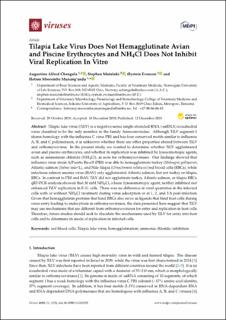| dc.contributor.author | Chengula, Augustino Alfred | |
| dc.contributor.author | Mutoloki, Stephen | |
| dc.contributor.author | Evensen, Øystein | |
| dc.contributor.author | Munang´andu, Hetron Mweemba | |
| dc.date.accessioned | 2020-08-04T12:42:43Z | |
| dc.date.available | 2020-08-04T12:42:43Z | |
| dc.date.created | 2020-01-18T22:22:22Z | |
| dc.date.issued | 2019 | |
| dc.identifier.issn | 1999-4915 | |
| dc.identifier.uri | https://hdl.handle.net/11250/2670801 | |
| dc.description.abstract | Tilapia lake virus (TiLV) is a negative-sense single-stranded RNA (-ssRNA) icosahedral virus classified to be the only member in the family Amnoonviridae. Although TiLV segment-1 shares homology with the influenza C virus PB1 and has four conserved motifs similar to influenza A, B, and C polymerases, it is unknown whether there are other properties shared between TiLV and orthomyxovirus. In the present study, we wanted to determine whether TiLV agglutinated avian and piscine erythrocytes, and whether its replication was inhibited by lysosomotropic agents, such as ammonium chloride (NH4Cl), as seen for orthomyxoviruses. Our findings showed that influenza virus strain A/Puerto Rico/8 (PR8) was able to hemagglutinate turkey (Meleagris gallopavo), Atlantic salmon (Salmo salar L), and Nile tilapia (Oreochromis niloticus) red blood cells (RBCs), while infectious salmon anemia virus (ISAV) only agglutinated Atlantic salmon, but not turkey or tilapia, RBCs. In contrast to PR8 and ISAV, TiLV did not agglutinate turkey, Atlantic salmon, or tilapia RBCs. qRT-PCR analysis showed that 30 mM NH4Cl, a basic lysosomotropic agent, neither inhibited nor enhanced TiLV replication in E-11 cells. There was no difference in viral quantities in the infected cells with or without NH4Cl treatment during virus adsorption or at 1, 2, and 3 h post-infection. Given that hemagglutinin proteins that bind RBCs also serve as ligands that bind host cells during virus entry leading to endocytosis in orthomyxoviruses, the data presented here suggest that TiLV may use mechanisms that are different from orthomyxoviruses for entry and replication in host cells. Therefore, future studies should seek to elucidate the mechanisms used by TiLV for entry into host cells and to determine its mode of replication in infected cells. | en_US |
| dc.language.iso | eng | en_US |
| dc.rights | Navngivelse 4.0 Internasjonal | * |
| dc.rights.uri | http://creativecommons.org/licenses/by/4.0/deed.no | * |
| dc.title | Tilapia lake virus does not hemagglutinate avian and piscine erythrocytes and NH4Cl does not inhibit viral replication in vitro | en_US |
| dc.type | Peer reviewed | en_US |
| dc.type | Journal article | en_US |
| dc.description.version | publishedVersion | en_US |
| dc.source.pagenumber | 1-12 | en_US |
| dc.source.volume | 11 | en_US |
| dc.source.journal | Viruses | en_US |
| dc.source.issue | 12 | en_US |
| dc.identifier.doi | 10.3390/v11121152 | |
| dc.identifier.cristin | 1776558 | |
| dc.relation.project | NORAD, direktoratet for utviklingssamarbeid: TAN/13/0027 | en_US |
| cristin.unitcode | 192,0,0,0 | |
| cristin.unitcode | 192,16,1,0 | |
| cristin.unitcode | 192,16,3,0 | |
| cristin.unitname | Norges miljø- og biovitenskapelige universitet | |
| cristin.unitname | Institutt for basalfag og akvamedisin | |
| cristin.unitname | Institutt for produksjonsdyrmedisin | |
| cristin.ispublished | true | |
| cristin.fulltext | original | |
| cristin.qualitycode | 1 | |

